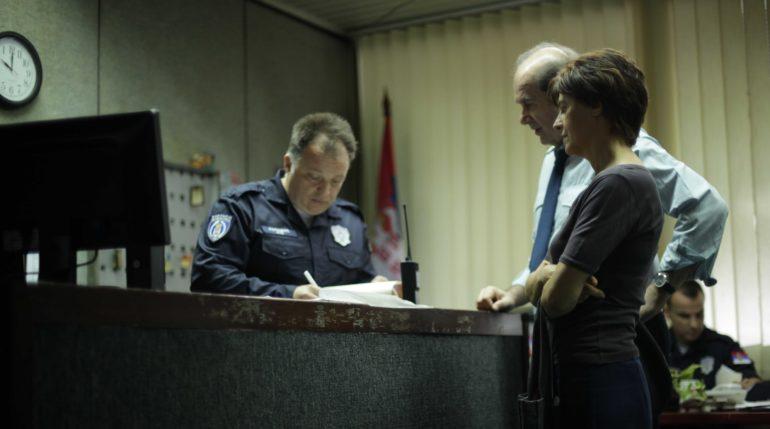Serbian Drama ‘Stitches’ Unravels Scandalous Secrets
By Christopher Vourlias
LOS ANGELES (Variety.com) – Eighteen years after she was informed of her newborn’s sudden death, a Belgrade seamstress still believes her infant son was stolen from her. Coldly dismissed by neighbors, the police, and hospital officials as paranoid, she summons up the strength to uncover the truth on her own in a riveting drama pulled from real-life events.
Miroslav Terzić’s “Stitches,” which world premiered at the Berlin Film Festival, features an engrossing performance by Snežana Bogdanović, one of the most celebrated actresses of former Yugoslavia. The film is produced by Uliks Fehmiu and Milena Trobozić Garfield for West End Productions, and co-produced by Nora Production Group (Slovenia), Spiritus Movens (Croatia) and SCCA/Pro.Ba (Bosnia and Herzegovina). Dubai-based Cercamon is handling world sales.
Terzić spoke to Variety about the real-life scandal that inspired his film, the courageous woman at its heart, and the search for the truth about a dark chapter of Serbian history that’s been buried in the past.
“Stitches” is based on the true and scandalous story of newborn babies being stolen from Serbian hospitals 20 years ago to be illegally sold for adoption. What inspired you to turn that story into a feature film?
I started to investigate this topic 17 or 18 years ago. I’d just become a first-time father, and read a magazine story about the stolen babies. Years later, after my first movie, I went to a small shop in Belgrade to repair my jeans. The [seamstress] told me she needed 20 minutes. My aunt lived nearby, so I stopped by to have a coffee. She asked me, “What are you doing now that the first film is finished? Do you have another topic to deal with?” I told her about the stolen babies, and she said, “But the seamstress is the most famous case!”
I went back and told her who I am. And I asked her, “Would you be so kind to tell me your story?” We did the interview, and after I asked my DP to turn off the camera. I stood up and asked, “Can I hug you?” because I had never met such a brave person in my life. Her story was the cornerstone for ours. She’s very humble, dignified and intelligent. And she’s fighting by herself. Right now she has seven legal battles [ongoing]. She wants to find the proof of where the babies are buried, but no one can tell her.
The film is a portrait of a woman who’s determined to find the truth, even when everyone around her insists she’s wrong, or even mad. She’s doubted, bullied. It’s a remarkable portrait of courage in a society where women’s voices aren’t always heard.
What was the process of bringing this incredible true story to life on screen?
Once we had Drinka’s story, Elma Tataragić finished the script in seven months. We rewrote for a year, and then we started trying to find money. This was the hardest part. I’m glad to have a co-production between Serbia, Croatia, Slovenia and Bosnia, ex-Yugoslavian countries. We are gathering around because this topic is important to all of us. Lots of people can connect with this story, and with this emotion.
Snežana Bogdanovićis one of the most acclaimed actresses in former Yugoslavia. Did you have her in mind for this part from the very beginning?
When I met Drinka, I thought Snežana would be great for this role. Even if we didn’t have a word of script, we knew. I watched her thirty years ago in a film called “Kuduz,” when she was nominated for the European [Film Awards] best actress. I called her and told her, “If you want, that role is yours.”
We started to talk, and Snežana met Drinka. Snežana has the same posture, beautiful green eyes, she copied everything that Drinka does, and Drinka taught her how to sew. They became really good friends. They love each other. This is one of the most important things, that Drinka loved our film.
What did you and DoP Damjan Radovanovic discuss when it came to the visual aesthetic of the movie?
Damjan is a wonderful cinematographer, and one of my closest friends. We talked a lot about this film, and we made rules. We never have a camera behind her back. She’s the darkest part of the screen. But I said to him I want her green eyes to be what people see first. In my opinion, he’s one of the best cinematographers right now in Europe. The most important thing is that he listens. He’s present in the situation. He’s going for the [aesthetic of the] film, not just beautiful light. He makes a little bit of a rough picture, but it’s emotionally strong, striking.
Towards the end of the movie, a woman asks Ana what she’s looking for, and she says, “The truth.” Do you think her search, and this story of a chapter in Serbian history that’s been buried, speaks to a larger question of truth and justice in your country, and how it deals with its past?
This is a story that’s connected to the last 50 years. For me it’s really interesting how we do not have any solved cases right now. No one has solved them publicly. There is a wish, but behind the words nothing happens. I don’t know why. Sometimes I’m really furious, because we’re really helpless. This film is a voice for people who are really helpless.
To be a parent who deals with this burden, with this system that changes from time to time, but is basically always the same. This world we live in – Facebook, Instagram – is superficial. There is nothing deep. I think the lack of empathy is something that will kill us, because we start to live just our life and don’t care what’s happening to the people around us.

